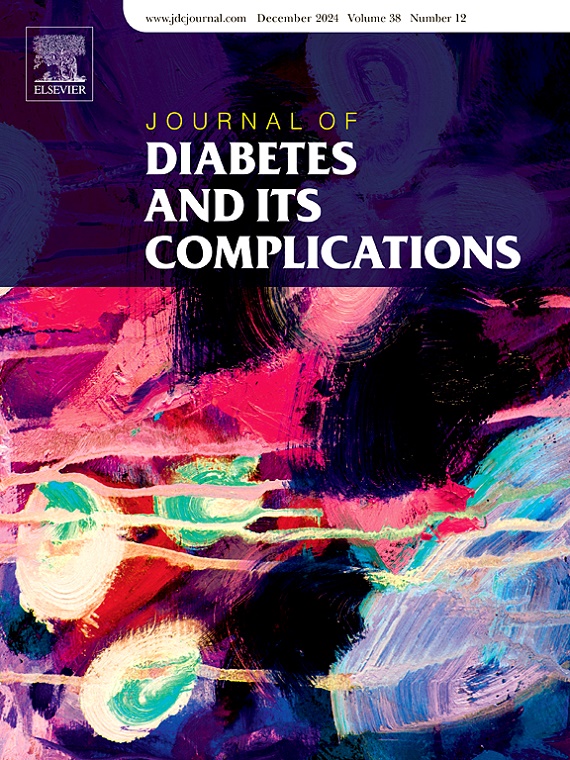Type 2 diabetes and cardiovascular conditions prediction in individuals with metabolic syndrome-associated lipoprotein lipase gene (LPL) single nucleotide polymorphisms (SNPs)
IF 3.1
3区 医学
Q3 ENDOCRINOLOGY & METABOLISM
引用次数: 0
Abstract
Objective
Metabolic syndrome (MetS) is predictive of increased risk of type 2 diabetes (T2D) and cardiovascular conditions (CVC). Lipoprotein lipase gene (LPL) single nucleotide polymorphisms (SNPs) may be of importance to the eventual diagnosis of T2D and CVC. This study aimed to predict the diagnosis of T2D and CVC amongst individuals with LPL SNPs rs268, rs11542065, rs116403115, rs118204057, rs118204061, rs144466625, and rs547644955.
Methods
This is a retrospective study using the UK Biobank data. Variables associated with MetS, T2D and CVC were selected from the data set. The total number of subjects in the cohort was 12,872 (mean age 56 years ± 8.1, 90.0 % were of British ethnicity, and 53.9 % were females). Logistic regression was used to assess whether the T2D and CVC can be predicted based on the presence of LPL SNPs and some of the clinical measures.
Results
Prediction models using clinical parameters showed good area under the curve (AUC) for prediction of T2D and CVC diagnosis (in receiver operating characteristic (ROC) analysis, area under the curve (AUC) = 0.959 for T2D, AUC = 0.772 for CVC). The addition of Polygenic Risk Scores (PRS/s) showed an improvement for diagnosis of both (AUC = 0.961 and 0.790 for TD and CVC, respectively). Further addition of SNPs showed more increase in AUC (AUC = 0.965 and 0.837 for T2D and CVC, respectively). The additive effect of the PRSs and LPL SNPs was more pronounced in the CVC than in the T2D model. The variant that had major significance for both T2D and CVC diagnoses was rs547644955 (AUC 1.0 and 0.910, respectively). The SNPs rs116403115 and rs118204057 both had an AUC of 1.0 for T2D diagnosis.
Conclusion
The prediction of T2D and CVC diagnoses with the use of clinically available factors may be enhanced with the addition of PRSs and SNPs, including LPL SNPs, which may have implications for stratified or personalised approaches for disease prevention or treatment.
代谢综合征相关脂蛋白脂肪酶基因(LPL)单核苷酸多态性(SNPs)个体对2型糖尿病和心血管疾病的预测
目的代谢综合征(MetS)可预测2型糖尿病(T2D)和心血管疾病(CVC)的风险增加。脂蛋白脂肪酶基因(LPL)单核苷酸多态性(snp)可能对T2D和CVC的最终诊断有重要意义。本研究旨在预测LPL snp rs268、rs11542065、rs116403115、rs118204057、rs118204061、rs144466625和rss547644955个体对T2D和CVC的诊断。方法采用英国生物银行数据进行回顾性研究。从数据集中选择与MetS、T2D和CVC相关的变量。该队列的受试者总数为12872人(平均年龄56岁±8.1岁,90.0%为英国裔,53.9%为女性)。采用Logistic回归来评估是否可以根据LPL snp的存在和一些临床指标来预测T2D和CVC。结果临床参数预测模型对T2D和CVC诊断的曲线下面积(AUC)预测较好(受试者工作特征(ROC)分析,T2D的曲线下面积(AUC) = 0.959, CVC的曲线下面积(AUC) = 0.772)。多基因风险评分(PRS/s)的增加对TD和CVC的诊断均有改善(AUC分别为0.961和0.790)。SNPs的进一步增加增加了T2D和CVC的AUC (AUC分别为0.965和0.837)。PRSs和LPL snp的加性效应在CVC模型中比在T2D模型中更为明显。对T2D和CVC诊断均有重要意义的变异为rs547644955 (AUC分别为1.0和0.910)。snp rs116403115和rs118204057诊断T2D的AUC均为1.0。结论使用临床可用因素预测T2D和CVC诊断可能会随着PRSs和snp(包括LPL snp)的增加而增强,这可能对疾病预防或治疗的分层或个性化方法具有重要意义。
本文章由计算机程序翻译,如有差异,请以英文原文为准。
求助全文
约1分钟内获得全文
求助全文
来源期刊

Journal of diabetes and its complications
医学-内分泌学与代谢
CiteScore
5.90
自引率
3.30%
发文量
153
审稿时长
16 days
期刊介绍:
Journal of Diabetes and Its Complications (JDC) is a journal for health care practitioners and researchers, that publishes original research about the pathogenesis, diagnosis and management of diabetes mellitus and its complications. JDC also publishes articles on physiological and molecular aspects of glucose homeostasis.
The primary purpose of JDC is to act as a source of information usable by diabetes practitioners and researchers to increase their knowledge about mechanisms of diabetes and complications development, and promote better management of people with diabetes who are at risk for those complications.
Manuscripts submitted to JDC can report any aspect of basic, translational or clinical research as well as epidemiology. Topics can range broadly from early prediabetes to late-stage complicated diabetes. Topics relevant to basic/translational reports include pancreatic islet dysfunction and insulin resistance, altered adipose tissue function in diabetes, altered neuronal control of glucose homeostasis and mechanisms of drug action. Topics relevant to diabetic complications include diabetic retinopathy, neuropathy and nephropathy; peripheral vascular disease and coronary heart disease; gastrointestinal disorders, renal failure and impotence; and hypertension and hyperlipidemia.
 求助内容:
求助内容: 应助结果提醒方式:
应助结果提醒方式:


